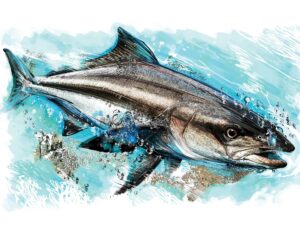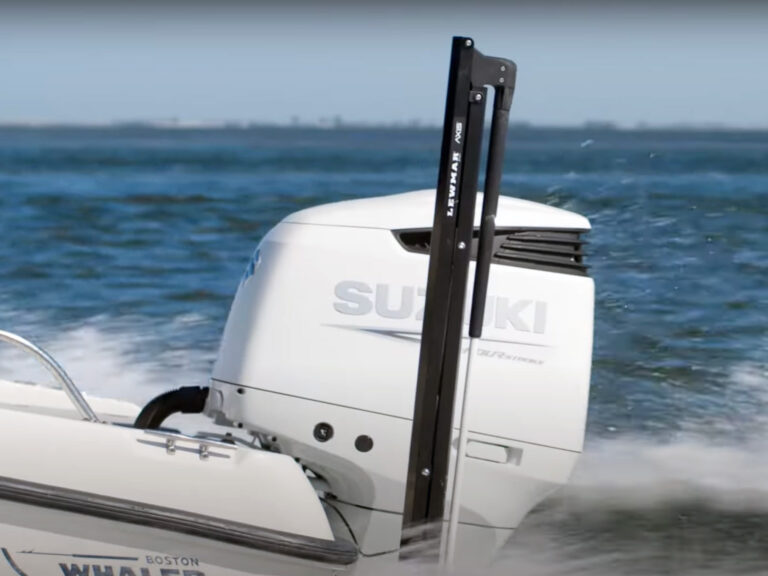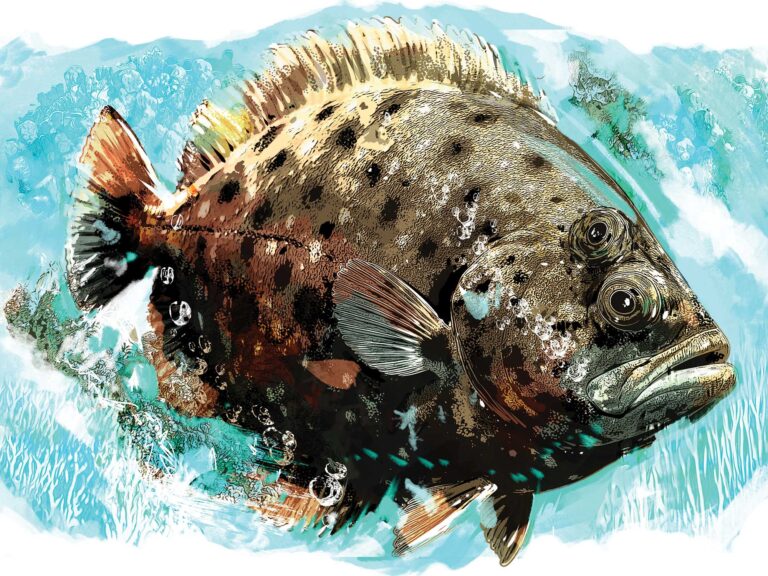
Outboard engines power more saltwater-fishing boats than any other type of motor. It’s little wonder: Outboards from brands such as Evinrude, Honda, Mercury, Suzuki and Yamaha offer superb power-to-weight ratios, and require relatively simple maintenance. You’ll find outboards on boats ranging from flats skiffs to 40-plus-foot offshore machines, in single and multiple configurations, and in horsepower ratings from 60 to more than 550.
Outboards have become so reliable that it’s easy to take them for granted. Yet anglers should understand the fundamentals of how these modern marvels operate and how to care for them. Let’s look at the basics from top to bottom when it comes to understanding the different parts on a boat motor and boat engine maintenance. In simple terms, we also explain how an outboard engine works.
Outboard Engine Cowl
The outboard cowl or hood protects the powerhead and its components from immersion. A rubberized gasket around the base of the cowl and compression latches seal out water. For this reason, it’s important to check the gasket and latches from time to time to make sure they’re in good condition and working properly. Cowls also feature baffled intakes that allow air to enter while also quickly shedding any water that sneaks in.

Outboard Engine Powerhead
Under the cowl is the powerhead — the engine and its components, such as the electronic fuel-injection system, electronic control module, alternator, starter, cable ports and, in the case of a two-stroke, oil-injection system. Outboards designed for saltwater-fishing boats feature in-line-four, V-6 and V-8 cylinder configurations, and the majority are four-strokes. Most powerheads sit “on end” with the crankshaft in a vertical orientation.
A four-stroke requires engine oil, while a two‑stroke relies on oil injection. Maintenance is required for both. With two-stroke outboard motor maintenance, you need to regularly fill the oil-injection reservoir with TC-W3 oil, and periodically clean the filter screen. With a four-stroke outboard motor maintenance, oil and oil-filter changes are required at regular intervals, using FC-W oil. Four-stroke engines also require periodic valve adjustments to ensure efficient operation. Check your owner’s manual for this scheduled service; when it’s time, have a qualified outboard technician handle it.
A maintenance item you can perform is flushing the engine with fresh water after each outing. Many engines have special ports for attaching a garden hose to rinse the internal cooling-water passages without running the engine. If you keep your boat on a trailer, you can use a flushing attachment known as “ear muffs.” It goes around the water pickups to supply fresh water from a garden hose while you run the engine in neutral at idle speed for a few minutes to flush away any salt.
Outboard Motor Throttle and Shift
While some new outboards feature “fly-by-wire” digital throttle-and-shift systems, many still utilize mechanical cables from the helm to the powerhead, and these require periodic inspection and lubrication. Pay particular attention to the points where the cables connect to the control box and engine. Check your owner’s manual for the maintenance procedures and perform these as recommended, or if the throttle and shift functions become balky. If difficulties persist, ask a qualified outboard technician to inspect the throttle-and-shift system. Cables can wear out, and it might be time to replace them.

Outboard Engine Fuel System
Virtually all outboards burn gasoline, and most feature the convenience of electronic fuel injection (EFI), which is vastly superior to the carburetors of yesteryear. EFI outboards are easy to start, require little warm-up time, and offer improved fuel efficiency.
Issues with ethanol-laced gas have placed a greater emphasis on maintenance of the fuel system. It starts with filling up. Today’s outboards are not designed to burn gas with more than 10 percent ethanol (E10). Avoid fuels with greater ethanol content. However, even E10 can create problems. As little as 0.5 percent water (measured against the volume of fuel) can trigger phase separation, in which ethanol separates from the gas and combines with the water to form a noncombustible goop that descends to the bottom of the fuel tank. Once sucked into the fuel system, it can damage components and kill the engine.
To help avoid phase separation, use a fuel additive such as Sta-Bil Ethanol Treatment, Star Tron Enzyme Fuel Treatment or ValvTect Ethanol Gasoline Treatment each time you fill up. Also, use a 10-micron, canister-style fuel filter to capture any of the goop before it enters the EFI system. Change the filter element every 50 hours of engine time.
Outboard Motor Transom-Mount Design
With the motor(s) technically outside the boat, the cockpit becomes more spacious for fishing. This also frees up the bilge area for items such as fish lockers. Yet, outboards can become an obstacle when fighting a fish around the stern, particularly when mounted on brackets that position them farther aft. Some transom designs allow you to step onto a platform to work a fish around the back.
Outboards also eliminate the need for large holes in the boat (as needed for the drive train components of inboards, sterndrives or pod drives), so there’s no chance of springing a leak from a ruptured seal. An outboard eases service; you don’t have to wedge yourself into the bilge to check the oil or change the spark plugs. Secured with just four bolts (in most cases), outboards are also simpler to replace than any other motors.
However, the engine’s aluminum drive casings and mechanisms — such as the mounting bracket, pivot tube, tilt-and-trim system, steering components and cables — are bathed in salt water. You need to be vigilant when it comes to maintaining these items.

Boat Motor Tilt and Trim
The power tilt-and-trim feature allows you to lower or raise the drive, using a switch on the control box (with a second switch on the outside of the engine). When trimmed inward all the way, the drive angles slightly forward in what is called negative trim. When vertical, the outboard is in neutral trim; moving the lower unit outward puts the drive into positive trim. The first 20 degrees outward travel is trim; the rest is tilt.
With the tilt function (intended for use only when the engine is off) you can elevate the drive out of the water while the boat is docked. This unique advantage helps minimize outboard corrosion. It can also prove helpful when fishing the shallows. You can tilt the outboard up to decrease your draft by several inches. If you trailer your boat, tilt is essential, allowing you to raise the lower unit so it doesn’t strike the pavement.
When underway, trim lets you to adjust the running attitude — the angle of the boat’s bow — by trimming in (to lower the bow) or out (to raise the bow) to achieve the smoothest and most efficient ride. In a head sea, for example, trimming in lowers the bow, allowing it to knife through waves. In a calm sea, you might want to trim out to raise the bow for less wetted surface and greater efficiency. However, too much positive trim can lead to “porpoising,” with the bow rising and falling in a disconcerting oscillation. Trimming in brings this under control.
Outboard Engine Steering
An outboard directs its thrust. This is also a big advantage when it comes to steering because directed thrust offers superb control when turning, particularly at low speeds. Outboards are not unique in this respect: Sterndrives and pod drives offer directed thrust, but the engine resides inside the boat.
The vast majority of saltwater boats today use one of two types of steering: hydraulic or power-assisted hydraulic. For single- and most twin-outboard applications, hydraulic steering ranks as the most popular. In these systems, from companies such as SeaStar Solutions and Uflex, the helm is a manual pump. As you turn the wheel, it delivers hydraulic pressure to an actuator attached to the outboard. Check valves in the system eliminate any feedback, easing the task of steering.
Power-assisted hydraulic steering is based on the same principle but uses an electric motor to help drive hydraulic pressure. This is helpful with steering multiple high-horsepower outboards. Mercury, SeaStar and Yamaha offer such systems. Joystick low-speed steering, which uses power-assisted hydraulic actuators, is also available for multiple outboard installations from the same companies.
While all types of hydraulic-steering systems have proved reliable, you should periodically check the fluid level and “bleed” the lines if steering becomes sloppy due to air in the system. Also, regularly look for hydraulic fluid leaks at the helm, hose connectors and around the actuators. If you see any leaks, have the system serviced as soon as possible.

The Shaft Length of Your Outboard Engine
Outboards come in four shaft lengths: S (15 inches), L (20 inches), XL (25 inches) and XXL (30 inches). Shaft length is driven by transom height, and except for some technical-poling skiffs, most saltwater-fishing boats run XL or XXL outboard shafts. The idea is to position the lower unit below the running surface to supply the propeller with enough clean water to achieve a “bite” and efficiently propel the boat. An offshore-fishing boat with triple or quadruple outboards usually has both, with the longer shafts for the center engine(s) and shorter shafts for the outside engines. This is because the V-shape of the running surface at the transom creates a deeper hull toward the center than on either side.
Outboard Motor Lower Unit
The engine feeds power through a vertical driveshaft (in the down housing or midsection) to the lower unit, where you will find the anti-ventilation plate, cooling-water pickups, propeller and skeg. The lower unit also houses the water-pump assembly. Within the gear case, the drive train makes a 90-degree turn and becomes the prop shaft. In most outboards, forward and reverse gears are also located here, as is the exhaust exit.
Regular servicing of components within the lower unit helps ensure efficient and trouble-free delivery of power to the water. This includes removing the propeller every few trips to check for fishing line around the prop shaft. Left unattended, line can melt and cut into the prop-shaft seal, allowing water inside the gear case. If that happens, get the outboard to a service shop to replace the seal as soon as possible, as the water can quickly damage bearings and gears. Before re-installing the propeller, apply a generous coat of fresh marine grease.
Lube in the gear case should also be changed, per the recommended service intervals, with the appropriate oil. And finally, have the water-pump impeller and related parts replaced according to the service schedule.

Outboard Engine Propeller
Ultimately, it is the propeller that delivers power to the water. For maximum performance, make sure the prop is sized correctly and in good condition. Propellers are classified by diameter and pitch, as well as by material and number of blades. Pitch — a number that indicates the theoretical distance of travel (in inches) with each rotation of the prop — is the most important. Prop choice can vary widely, depending on the boat and motor combination, as well as how heavily or lightly the boat is loaded. As a rule, a prop should allow the engine to rev up to its maximum-rated rpm at wide-open throttle.
In multi-outboard setups, each engine might have a slightly different propeller. With twin outboards, for example, the gear cases usually rotate in opposite directions, requiring a right-handed rotation prop for one outboard, and a left-handed rotation for the other. The counter-rotating propellers nullify any prop torque, which otherwise can cause a boat to heel over at speed.
With three outboards, the center engine is often equipped with a four-blade prop, while the outside engines have three-blade models. The center outboard handles much of the work during acceleration, and four-blade props are better for this. In cruise mode, the outside engines shoulder the work, and three-blades are more efficient at these speeds.
Whatever prop you’re running, check the blades regularly for damage. Dings and missing chunks are easy to spot, but a slightly bent blade might not be readily apparent, though it often creates an odd vibration. Most damage requires the expertise of a prop shop for repair and rebalancing.
To prevent damage to the rest of the drive train, the hubs of outboard propellers are designed to give way if the prop strikes an object. However, hubs can also wear out with time and heat. If your prop is 10 years old or older, it’s a good idea to have a prop shop check the hub.

Outboard Horsepower Decisions
Bear in mind that outboard boats have maximum-horsepower ratings, so for safety’s sake, avoid exceeding this. At the same time, an underpowered boat will struggle to stay on plane, and can become overwhelmed in rough seas. For top efficiency and performance, power your boat at or just slightly below its maximum-horsepower rating.
A wise man once told me, “Take care of your equipment, and it will take care of you.” Apply this to your outboard, and it will power your fishing trips for years to come.








